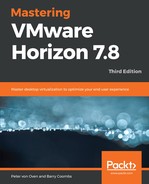As with the sizing of View for virtual desktop machines, configuring the right specification for the RDSH servers is also key, and in a similar way in which we consider the desktop sizing, we are going to look at different user types.
The VMware recommendation for the user workloads and the memory requirements are shown in the following table:

For the total memory in each RDSH server, VMware recommends that a virtual machine configured as an RDSH server should be provisioned with 64 GB memory, and in terms of CPU requirements, the VMware recommendation is to create virtual servers for the RDSH roles and configure each one with four vCPUs. Make sure that you do not overcommit on the number of cores.
So, for example, if you had a virtual machine running as an RDSH server configured with 64 GB of memory, and had heavy users hosted on it, you would be able to host a maximum of 64 sessions on that server.
For the hardware configuration, let's say you had a physical ESXi host server, configured with a 2-socket CPU that had 12 cores, giving you a total of 24 cores.
This would allow a maximum of 6 RDSH servers as we are going to provision virtual machines for the RDSH role that each has 4 cores (24 cores/4 cores per server). That would mean that the physical server would also need to be configured with 384 GB of memory in total (64 GB x 6 RDSH host servers).
These figures are only guidelines and are based on some of the VMware-recommended best practices. It is always best to run an assessment on your environment to work out your optimum configuration.
In the next section, we are going to install and configure the View-hosted applications feature.
